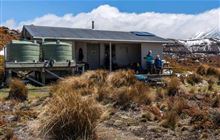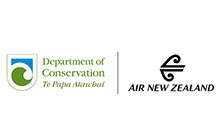Tongariro Northern Circuit
Located in Tongariro National Park in the Central North Island region
|
Introduction
From late October to April, explore the volcanic heart of Tongariro National Park, a landscape of stark glacial contrasts and alpine views. From May to late October, it can be cold and wet, with ice, snow, avalanches and short daylight hours - only go if you have navigation and alpine skills.Bookings are not required for Tongariro Northern Circuit huts outside the Great Walk season (May to late October). During this time huts are first come, first served. Fees still apply.
Bookings are open for the 2024/25 Great Walk season.
44.9 km loop
Walking and tramping
3-4 days Intermediate: Great Walk/Easier tramping trackAdvanced: Tramping track
Expert: Route
Seasonal restrictions
In the Great Walks season (25 October 2024 – 30 April 2025)
Best time to walk the track - there are more facilities and fewer hazards. Bookings are required for huts and campsites. Intermediate track category.
Outside the Great Walks season (1 May – 24 October)
Walking the track should only be attempted by fit, experienced and well-equipped people - facilities are greatly reduced and there are additional hazards. Advanced and expert track categories. Hut bookings are not required. Huts are first come, first served but fees still apply.
Dog access
Image gallery
-
Taranaki Falls plunge into a boulder-ringed pool Image: Robert Dickinson ©
![Taranaki Falls. Taranaki Falls.]()
-
Journey through alpine meadow landscapes and emerald coloured lakes Image: | DOC
![Women by emerald lake on Tongariro Northern Circuit. Women by emerald lake on Tongariro Northern Circuit.]()
-
Boardwalk on Tongariro Northern Circuit Image: | DOC
![Boardwalk on Tongariro Northern Circuit. Boardwalk on Tongariro Northern Circuit.]()
-
Trampers on Tongariro Northern Circuit Image: Sarah Wilcox | Creative Commons
![Trampers on Tongariro Northern Circuit. Trampers on Tongariro Northern Circuit.]()
-
View from the Tongariro Northern Circuit Image: Tahu Taylor-Koolen ©
![View from the Tongariro Northern Circuit. View from the Tongariro Northern Circuit.]()
May to late October (winter season): Walking the track outside the Great Walks season should only be attempted if you have alpine skills, equipment and experience.
Walking options
The Tongariro Northern Circuit can be walked either direction.
Most walkers take 4 days/3 nights or 3 days/2 nights. Very fit people can walk it in 2 days/1 night, but each day is at least 8 hours.
We recommend runners who plan to complete the circuit in a day book to use the Tongariro Alpine Crossing track. Track users with a Tongariro Northern Circuit hut or campsite booking do not need to make a booking for the Tongariro Alpine Crossing track.
Note: climbing the peaks of Mounts Ngauruhoe and Tongariro is disrespectful and unacceptable to Ngāti Tūwharetoa. Ngāti Tūwharetoa are the iwi who made the tuku/gift of these sacred peaks to Aotearoa New Zealand.
Places to stay
There are three huts with campsites nearby along the Tongariro Northern Circuit. These must be booked in advance during the Great Walks season. Camping is not allowed within 500m of this track.
Huts have bunks, mattresses, heating, toilets, basic gas cooking facilities, solar-powered lighting and cold running water. A DOC ranger is present. The huts do not provide food, cooking utensils or showers.
Whakapapa Village to Mangatepopo Hut
Time: 3-5 hr, weather dependent
Distance: 9.4 km
Begin 100 m below the Whakapapa Visitor Centre at Ngauruhoe Place and along the lower Taranaki Falls track. After about 20 min the Mangatepopo track branches off from the Taranaki Falls track. From this point the remaining time to Mangatepopo Hut is approximately 3 hr, or up to 5 hr in poor weather conditions.
The track is heavily eroded in places and includes many stream crossings. Walkers are advised to take extra care around these areas to avoid slips and falls, particularly in inclement weather.
Ahead and to the right is Pukekaikiore, thought to be one of the older vents of the Tongariro complex. To the left is Pukeonake, a low scoria cone. Both Pukekaikiore and Pukeonake witnessed the last ice age when glaciers from Tongariro carved down through Mangatepopo Valley. The giant cone of Ngauruhoe and the flatter form of Tongariro are visible ahead. Ngauruhoe is a younger ‘parasitic’ cone on the side of Tongariro.
For the last hour the track skirts around Pukekaikiore until it reaches the Mangatepopo Valley track. The Mangatepopo Hut is five minutes off of the main track.
Mangatepopo Hut to Emerald Lakes
Time: 3 hr 30 min
Distance: 8 km
The track follows Mangatepopo stream up the valley, climbing over a succession of old lava flows from Ngauruhoe. The youngest, very black, lava flows were erupted from Ngauruhoe in 1949 and 1954.
A five minute detour at the head of the valley leads to the cold Soda Springs and waterfall, which emerge beneath an old lava flow. In spring and summer moisture loving plants such as white foxgloves and yellow buttercups thrive in the area.
The steep climb required to reach the Mangatepopo Saddle rewards climbers views of the valley and if clear, Mt Taranaki to the west. From the saddle the track crosses South Crater, not a true crater but a drainage basin between the surrounding volcanic landforms.
Ahead more recent lava flows can be seen spilling over from Red Crater. The climb up to Red Crater offers splendid views of Oturere Valley and Kaimanawa Ranges to the east. Loose rocks and stones on the steep slopes of Red Crater present a major slip hazard - walkers are advised to extra time and care.
The main track continues on past the rim of Red Crater itself. The spectacular formation on the far side of the crater is a dike, an old magma feeding pipe to the vent of the volcano. Harder than the ash and scoria around it erosion has left it exposed on the side of the crater.
North Crater is the large flat topped crater to the north. This vent once contained a lava lake which cooled to infill the crater.
Blue Lake is visible from the top of Red Crater, across the Central Crater - which like South Crater is actually another drainage basin. Blue Lake has formed where cold fresh water fills an old vent.
A loose, rocky ridge leads down to the spectacular Emerald Lakes, which fill old explosion pits. Their brilliant colouring is caused by minerals washed down from the thermal area of Red Crater.
The Tongariro Alpine Crossing continues from Emerald Lakes to Ketetahi Road.
Emerald Lakes to Oturere Hut
Time: 1 hr 30 min
Distance: 4 km
From Emerald Lakes the track descends steeply into the Oturere Valley with views of the valley, the Kaimanawa Ranges and the Rangipo Desert. The track weaves through an endless variety of unusual jagged lava forms from early eruptions from Red Crater which filled Oturere Valley.
A magical place to visit especially on a misty day. The Oturere Hut is nestled on the eastern edge of these flows. There is a pretty waterfall over the ridge from the hut.
Oturere Hut to Waihohonu Hut
Time: 3 hr
Distance: 8.1 km
After leaving Oturere Hut the track undulates over a number of stream valleys and open gravel fields. Plant life here has been constantly repressed by volcanic eruptions, altitude and climate. Loose gravel means that recolonisation by plants is a slow process on the open and bare countryside.
The track gradually sidles around the foot hills of Ngauruhoe descending into a valley and crossing one of the branches of the Waihohonu Stream. Continue through a beech clad valley before climbing towards the ridge top. Waihohonu Hut is in the next valley.
Waihohonu Hut to Whakapapa Village
Distance: 15.4 km
Time: 5 hr
The track follows the Waihohonu stream and gradually climbs to Tama Saddle. This area can be windy as it sits between the mountains.
From the saddle there is a very worthwhile side trip to the striking Tama Lakes, two infilled explosion craters. The lower lake is only 10 minutes from the junction, while the upper lake is up a steep ridge, taking 1 hour 30 minutes return.
Whakapapa Village is about two hours from the Tama Lakes junction. After the first hour the track meets the Taranaki Falls loop walk, one of the best short walks in the Park. There are two options to return to the village, both take about an hour. To view the waterfall, follow the lower section of the track down the steps to its base, then follow the Wairere stream through beautiful mountain beech forest back to the village.
Alternatively take the upper section of track through open tussock and shrubland back to the village.
Side trip: Ohinepango Springs
Time: 1 hr return from Waihohonu Hut
Crystal clear cold water bubbles up from beneath the old lava flow and discharges at an enormous rate into the Ohinepango Stream.
The springs are signposted on the Round the Mountain Track heading south towards Rangipo Hut.
Side trip: Historic Waihohonu Hut
Time: 20 min return from Waihohonu Hut; 10 min return from the Tongariro Northern Circuit Track
Built in 1903/04, this was the first hut built in Tongariro National Park. It's the oldest example of a typical early two-room mountain hut in New Zealand. Historic Waihohonu Hut.
Side trip: Tama Lakes
Time: 20 min return to Lower Tama from the junction, 1 hr 30 min return to Upper Tama from the junction.
Access half way between Waihohonu Hut and Whakapapa Village.
Tama Lakes, two infilled explosion craters, are named after Tamatea, the high chief of the Takitimu Canoe, who explored the area six centuries ago.
The lower lake (at 1200 m), is 10 minutes from the junction. Volcanic debris is slowly washing in and filling the crater. The upper lake (at 1314 m) is a further 40 minutes up a steep ridge. This beautiful lake is reputed to be very deep.
You need to pay fees to stay at the huts and campsites on this track. Fees vary depending on when you go.
Hut fees
In the Great Walks season (25 October 2024 – 30 April 2025)
New Zealand citizens and those ordinarily resident in New Zealand:
- Adult (18+ years): $44 per person, per night
- Child (5 to 17 years): $22 per person, per night
International visitors:
- Adult (18 years and over): $66 per person, per night
- Child (17 years and under): $33 per person, per night
Proof of eligibility is required for the New Zealand rate.
Outside the Great Walks season (1 May – 24 October)
For all visitors:
- Adult (18 years and over): $25 per person, per night
- Child (5 to 17 years): $12.50 per person, per night
Bookings are not required. Before you go, buy 1 Serviced Hut Ticket (green) for each night's stay. Put these in the honesty box at the hut.
About hut tickets and passes | Retailers that sell hut tickets and passes
Campsite fees
In the Great Walks season (25 October 2024 – 30 April 2025)
New Zealand citizens and those ordinarily resident in New Zealand:
- Adult (18 years and over): $19 per person, per night
- Child (5 to 17 years): $9 per person, per night
International visitors:
- Adult (18 years and over): $28 per person, per night
- Child (17 years and under): $14 per person, per night
Proof of eligibility is required for the New Zealand rate.
Outside the Great Walks season (1 May – 24 October)
For all visitors:
- Adult (18+ years): $10 per person, per night
- Child (5 to 17 years): $5 per person, per night
Bookings
Bookings are not required for Tongariro Northern Circuit huts outside the Great Walk season (May to late October). During this time huts are first come, first served. Fees still apply.
Bookings are open for the 2024/25 Great Walk season.
In the Great Walks season (25 October 2024 – 30 April 2025)
Bookings are required for huts and campsites.
Book Tongariro Northern Circuit online
If you don’t have a valid booking for your stay, you may be charged a penalty, or turned away if the hut/campsite is full.
Outside the Great Walks season (1 May – 24 October)
Bookings are not required.
Bunks in huts are first come, first served.
Payment is with Backcountry Hut Tickets or a Backcountry Hut Pass – buy these from a DOC visitor centre before you go.
Tongariro Northern Circuit starts and ends in Whakapapa Village.
There are overnight parking areas in the village – visit the Tongariro National Park Visitor Centre for directions to these areas and to receive a free parking permit.
Public transport is an option. Bus and train services run to National Park Village, on route between Auckland and Wellington and 15 km from Whakapapa Village. Local shuttle services provide transfers to Whakapapa Village.
The track can also be accessed from parking areas at:
- Mangatepopo Road end, off SH 47. Note, there is a 4-hour parking restriction at the Mangatepopo road end throughout the Great Walk season. Visit the Tongariro National Park Visitor Centre for a free parking permit or have your booking ticket available for the traffic management team to sight.
- Waihohonu track access point off the Desert Road (SH1), 35 km south of Turangi.
May to late October (winter season): Special skills and preparation are required to complete the Tongariro Northern Circuit in winter. There is increased risk from snow, ice, avalanche terrain and sub-zero temperatures.
The terrain is difficult
Most of the track is open, difficult, exposed and on uneven surfaces.
Track is not recommended for children under the age of 10. The track travels over exposed mountainous landscapes and often with adverse weather conditions.
Be prepared for all weather conditions
Weather can change suddenly, from warm and sunny to cold and wet with strong winds. Dress warmly as wind-chill can be severe. Be prepared for all conditions. Check the Tongariro National Park weather forecast (NIWA website).
There are several active volcanic vents
The Tongariro Northern Circuit passes through volcanic hazard zones – even when the track is open, volcanic risk is present. Volcanic monitoring systems monitor activity and mitigate volcanic risk, but won't ensure your personal safety. If you are uncomfortable with this risk, choose a different track.
Mobile reception varies
Mobile reception is reasonably good along the track, but there are sections with no coverage. Generally there is no or very limited mobile coverage at Waihohonu Hut.
Tongariro Alpine Crossing booking system
We recommend runners who plan to complete the circuit in a day book to use the Tongariro Alpine Crossing track. Track users with a Tongariro Northern Circuit hut or campsite booking do not need to make a booking for the Tongariro Alpine Crossing.
Book to use any part of the Tongariro Alpine Crossing.
Read about why a booking is needed and sustainable visitor management for Tongariro.
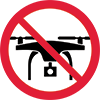 No drones
No drones
Unauthorised use of drones is prohibited. You must have a permit to fly a drone.
DOC does not generally approve permits to fly drones in this national park and we do not recommend you apply for one.
Personal equipment
- Backpack – 40–60 litre size for multi-day hiking
- Waterproof/plastic pack liner
- Sleeping bag – 3–4 season
- First aid kit including blister treatment materials
- Survival kit including survival blanket, whistle, paper, pencil, high energy snack food
- Safety equipment relevant to the track and time of year, for example, map, compass
- Torch/flashlight and spare batteries
- Rubbish bag
- Booking confirmation and ID
- Earplugs for communal bunkrooms
- An emergency shelter, for if you are trapped by flooded rivers or bad weather
- A distress beacon
Cooking and food equipment
- Drink bottle – 1–2 litre capacity
- Eating and cooking utensils – knife, fork, spoon, plate, cup, pot/pan/billy, cleaning kit, tea towel. Check individual huts for what cooking facilities and lighting are provided.
- Matches or lighter in waterproof container
Toiletries
- Toiletries, including insect repellent, sunscreen, and personal medication, for example, antihistamine for allergy to wasp stings
- Use a toilet when you see one and be prepared with a backup toilet option
- Some of our Great Walk huts have sanitary bins but do come prepared if there isn't one. Find out more about Menstruation in the backcountry.
If camping
- Tent
- Sleeping mat
- Ground sheet
- Gas cooker
Clothing
- For multi-day walking you'll need at least one set of clothes to walk in and another dry set to change into at night.
- Tramping/hiking boots or firm footwear – should be comfortable and well broken in
- Socks – wool or polypropylene
- Shorts – quick dry material
- Shirt – wool or polypropylene
- Under layers, top and bottom – wool or polypropylene
- Mid-layers – wool or polar fleece
- Raincoat – waterproof, windproof with hood
- Overtrousers – wind and waterproof
- Warm hat and gloves
- Sunhat and sunglasses
- Extra socks, underwear, shirt/lightweight jersey
Optional
- Gaiters
- Lightweight shoes for inside the huts
- Fire starters
Food
You cannot buy food on the track. Carry all the meals and snacks you will need, plus some spare, and a water bottle. We recommend food that is lightweight, fast cooking and high in energy value.
We do not provide emergency food in huts. You will need to carry emergency food supplies in case you are delayed by weather.
Store your food in a rodent-proof container or bag. This is especially important if you are camping
May to October
For safety reasons, the Tongariro Northern Circuit doesn't operate as a Great Walk/Easier tramping track during May to October. If attempting the Tongariro Northern Circuit in that time, you'll need additional equipment.
You need to be totally self-sufficient. In addition to what to take in the Great Walks season, you also need:
- food for at least two extra days
- stove and gas for cooking
- lighter or matches
- alpine equipment: ice axe and crampons
- avalanche equipment: beacon, snow shovel, avalanche probe.
- personal locator beacon
- mountain radio or satellite messenger (optional)
Outside the Great Walks season (1 May – 24 October)
During the winter season, the Tongariro Northern Circuit is not a Great Walk and has reduced facilities.
There is increased risk from snow, ice, avalanche terrain and sub-zero temperatures.
Suitable for people with alpine skills, equipment and experience. You must:
- know how to navigate if cloud or snow covers the marker poles and you cannot see them
- know where avalanches are a risk and be able to rescue someone if an avalanche occurs
- have the equipment and skills to prevent a slide on icy terrain
- have the clothing for sub-zero temperatures and be able to survive if the weather get worse.
Fees and bookings
Outside of the Great Walks season, hut fees are reduced and bookings are not required. Full information can be found in the fees and booking section for this track.
Expect challenging track conditions
Track surface: Track is covered in snow and very icy in sections.
Snow and ice is common in higher areas and sometimes on lower areas. Deep snow can hide track markers. At times, surface conditions can be hard ice.
View current conditions on webcams on the GeoNet website: Tongariro webcam | Ngauruhoe webcam | Ruapheu North webcam
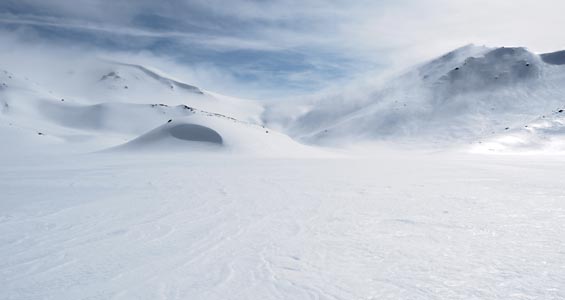 South Crater in winter
South Crater in winter
Image: Zhi Yuen Yap ©
Conditions are cold, wet and windy
During the winter months, Tongariro is frequently cold, wet and windy. Dress for the conditions.
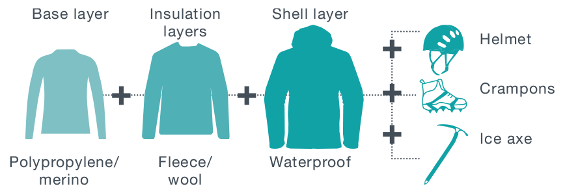
Avalanches are possible from July to October
Most of the track is simple terrain, however some sections of the Tongariro Northern Circuit track pass through challenging and complex avalanche terrain, including where it crosses over Red Crater between South Crater and Emerald Lakes
Avalanches are most common during the winter and spring (July to October) but can occur before or after that period. The avalanche hazard can change with very little warning.
If you are going into places avalanches could occur, be sure you:
- have checked the New Zealand Avalanche Advisory for Tongariro and the Avalanche Terrain Exposure Scale (ATES) for Tongariro National Park.
- have the skills for the ATES class you are going into
- take an avalanche transceiver, avalanche probe and a snow shovel. Know how to use these tools.
Expect reduced hut facilities
Hut facilities are reduced.
- Gas cookers are not provided – you need to bring your own cooking stove.
- Running water may not be available. Water can be obtained from the outside water tank; if this is frozen, then from the nearest watercourse or by melting snow. We recommend that you treat all stream water in case of giardia or other bugs.
- No DOC rangers.
- No emergency radio facilities.
Be totally self-sufficient
You need to be totally self-sufficient. In addition to what to take in the Great Walks season, you also need:
- food for at least two extra days
- stove and gas for cooking
- lighter or matches
- alpine equipment: ice axe and crampons
- avalanche equipment: beacon, snow shovel, avalanche probe
- personal locator beacon
- mountain radio or satellite messenger (optional).
Stay safe in the outdoors
- Choose the right trip for you. Learn about the route and make sure you have the skills for it.
- Understand the weather. Check weather forecasts.
- Pack warm clothes and extra food. Check gear lists.
- Share your plans and take ways to get help. Share directly or use the Outdoor Intentions form or Plan My Walk. Take a distress beacon.
- Take care of yourself and each other.
Contacts
| Tongariro National Park Visitor Centre | |
|---|---|
| Phone | +64 7 892 3729 |
| tongarirovc@doc.govt.nz | |
| Address | Whakapapa Village State Highway 48 Mount Ruapehu 3083 |
| Hours | Visitor centre hours and services |







